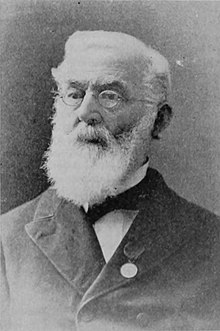James Hall (paleontologist)
| James Hall | |
|---|---|
 |
|
| Born | September 12, 1811 Hingham, Massachusetts |
| Died | August 7, 1898 (aged 86) Bethlehem, New Hampshire |
| Citizenship | American |
| Fields | geologist, paleontologist, stratigraphy |
| Doctoral advisor | Amos Eaton, Ebenezer Emmons |
James Hall (September 12, 1811 – August 7, 1898) was an American geologist and paleontologist. He was a noted authority on stratigraphy and had an influential role in the development of paleontology in the United States.
Hall was born in Hingham, Massachusetts, the oldest of four children. His parents, James Hall Sr. and Sousanna Dourdain Hall, had emigrated from England two years earlier. Hall developed an early interest in science and enrolled in Rensselaer Polytechnic Institute, a recently established college that emphasized student participation and focused on science. He was a student of Amos Eaton and Ebenezer Emmons, both notable geologists. Hall graduated with honors in 1832, received his master's degree in 1833, and remained at Rensselaer to teach chemistry and later geology.
In 1836 a multi-year survey was established to collect information on the geology and natural history of New York. For purposes of the survey, the state was divided into four districts, and Hall became assistant geologist for Ebenezer Emmons, chief of the Second District. Hall’s initial assignment was to study iron deposits in the Adirondack Mountains. The following year the survey was reorganized: Hall was put in charge of the Fourth District, in western New York. Other notable geologists working on the survey included Lardner Vanuxem and Timothy Conrad. Working together, the survey staff developed a stratigraphy for New York and set a precedent for naming stratigraphic divisions based on local geography.
At the end of the survey in 1841, Hall was named the first state paleontologist. In 1843 he made his final report on the survey of the fourth geological district, which was published as Geology of New York, Part IV. (1843). It was received with much acclaim and became a classic in the field. Hall had built a solid reputation and was to devote the rest of his life to stratigraphic geology and invertebrate paleontology.
...
Wikipedia
